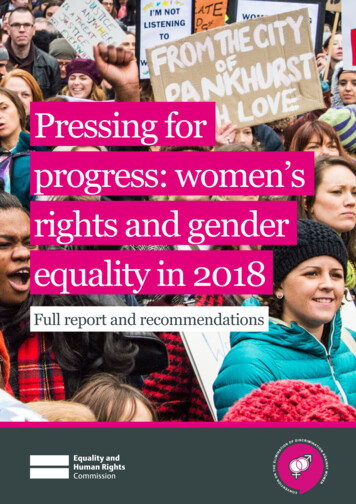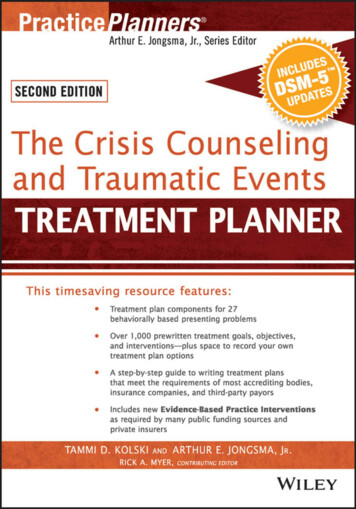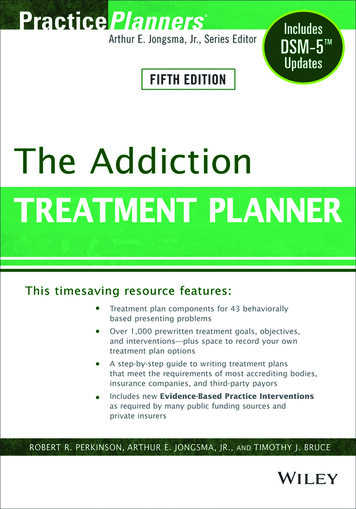
Transcription
Pressing forprogress: women’srights and genderequality in 2018Full report and recommendations
Pressing for progress: women’s rights and gender equality in 2018ContentsList of abbreviations4Introduction7Devolution and the scope of this report . 8Role and remit of the Equality and Human Rights Commission . 9Engagement with civil society . 101. Enhancing the status of international human rights in domestic law11Full implementation and incorporation of CEDAW. 11Human Rights Act 1998 . 12Full implementation of the Equality Act 2010 . 13Implications of leaving the European Union . 142. Participation in political and civic life17Political participation . 17Public and private appointments. 203. Gender-based violence, harassment and abuseBackground and context2222Sexual violence . 24Domestic violence, abuse and femicide . 28Harmful practices. 35Hate crime, hate speech and identity-based harassment . 444. Access to civil justice48Legal aid . 48Employment tribunals . 505. Human trafficking and modern slavery53Modern slavery . 53Strengthening the National Referral Mechanism . 562
Pressing for progress: women’s rights and gender equality in 20186. Detention and asylum58Women in prison. 58Immigration detention . 61Asylum seekers’ access to services . 647. Adequate standard of living and social security68Cumulative impact of welfare and tax changes . 68Specific changes to the social security system . 70Changes to the state pension age . 73Housing and homelessness. 758. Just and fair conditions of work79Women in work . 79Discrimination and harassment in the workplace. 83Occupational segregation . 86Pay . 889. Highest attainable standard of health92Mental and physical health . 92Sexual and reproductive health and rights . 9610. Equality in education100Bias in subject choices . 100Personal, social, health and economic (PSHE) and relationships and sexeducation . 102Bullying and harassment in schools . 104Contacts1083
Pressing for progress: women’s rights and gender equality in 2018List of abbreviationsAMsAssembly MembersBISDepartment for Business, Innovation and SkillsCCGsClinical commissioning groupsCEDAWConvention on the Elimination of All Forms of DiscriminationAgainst WomenCOConcluding ObservationsCPSCrown Prosecution ServiceCQCCare Quality CommissionDfEDepartment for EducationDWPDepartment for Work and PensionsEAEquality ActECHREuropean Convention on Human RightsEHRCEquality and Human Rights CommissionEUEuropean UnionFGMFemale genital mutilationFMUForced Marriage UnitHBV‘Honour-based’ violenceHMCPSIHM Crown Prosecution Service InspectorateHMICHM Inspector of ConstabularyHMICFRSHer Majesty’s Inspectorate of Constabulary and Fire andRescue ServicesHMI PrisonsHM Inspectorate of PrisonsHPVHuman papilloma virus4
Pressing for progress: women’s rights and gender equality in 2018HRAHuman Rights ActIRCImmigration Removal CentreIVFIn vitro fertilisationJCHRJoint Committee on Human RightsLASPOLegal Aid, Sentencing and Punishment of Offenders Act 2012LGBTLesbian, gay, bisexual and transMSAModern Slavery ActNHRIsNational Human Rights InstitutionsNICsNational Insurance contributionsNICENational Institute for Health and Care ExcellenceNLWNational Living WageNMWNational Minimum WageNRMNational Referral MechanismONSOffice for National StatisticsPSHE/PSEPersonal, social, health and economicRSERelationships and sex educationSDGSustainable Development GoalSPAState pension ageSR VAWSpecial Rapporteur on violence against womenSTEMScience, technology, engineering and mathematicsSTISexually transmitted infectionTUCTrades Union CongressUCUniversal CreditUCASUniversities and Colleges Admissions ServiceUKUnited KingdomUNUnited NationsVAWGViolence against women and girls5
Pressing for progress: women’s rights and gender equality in 2018WASPIWomen Against State Pension InequalityWAVEWomen Adding Value to the EconomyYWTYoung Women’s Trust6
Pressing for progress: women’s rights and gender equality in 2018IntroductionThis report represents the response of the Equality and Human Rights Commission(the EHRC) to the UK Government’s eighth periodic report to the United NationsCommittee on the Elimination of All Forms of Discrimination Against Women.The EHRC recognises and commends the progress made in the implementation ofthe Convention on the Elimination of All Forms of Discrimination Against Women(CEDAW) since it was last reviewed in 2013, including: criminalising forced marriage (see page 43) introducing the Modern Slavery Act (see page 53) introducing shared parental leave (see page 82) bringing in tougher gender pay gap regulations (see page 89), and committing to establish mandatory, age-appropriate relationships and sexeducation (see page 103).Nevertheless, we also focus on areas in which there has been insufficient progress,or are ongoing challenges in the realisation of CEDAW. Our report relates to 73% ofthe substantive Concluding Observations issued by the CEDAW Committee in 2013,many of which are still outstanding or not fully implemented.Women’s rights, gender equality and social norms have been the subject of muchnational and international debate in recent months. In the UK, a series of incidentshave called into question the rigid set of assumptions many still have of women andgirls and the significant problems they face, such as sexual harassment in schoolsand in the workplace (see pages 83-85 and 104-107).This wide-ranging report – our broadest ever review into women’s rights – seeks todemonstrate the extent to which gender inequality affects the various facets ofwomen’s lives. Recognising that women have diverse lived experiences, we havesought to include intersectional analysis where evidence allowed. However,persistent gaps in data disaggregated by protected characteristics remain, making itharder to identify multiple discrimination and disadvantage. The EHRC is clear,however, that CEDAW protects and relates to all women, and our recommendationsshould be read as applying to all groups of women.7
Pressing for progress: women’s rights and gender equality in 2018This report also highlights the sometimes serious and extreme consequences ofwomen’s inequality. EHRC research has found that there is a clear link betweencommonly held, prejudiced attitudes and unlawful behaviour. 1 This aligns with theCEDAW Committee’s recent general recommendation on violence against women,which states that ‘the need to assert male control or power, enforce gender roles, orprevent, discourage or punish what is considered to be unacceptable femalebehaviour contribute to the explicit or implicit social acceptance of gender-basedviolence against women and to the widespread impunity in that regard’. 2Our aim is to encourage the UK and Welsh governments to use the CEDAWreporting process to continue and strengthen their efforts to assess progress andimprove compliance with their human rights obligations. To this end, our submissionincludes specific recommendations, which we believe can support this importanttask.Devolution and the scope of this reportThe UK comprises four countries – England, Scotland, Wales and Northern Ireland.The UK Parliament has devolved various powers to the Scottish Parliament, theNational Assembly for Wales and the Northern Ireland Assembly, and it maintainsresponsibility for matters that have not been devolved (‘reserved’ matters) and forEngland. Responsibility for implementing CEDAW therefore lies with the UK anddevolved governments.In addition, there are three separate legal systems in the UK – England and Wales,Scotland and Northern Ireland. The Supreme Court is the UK’s highest court of law.It is the final court of appeal for all UK civil cases. It also decides ‘devolution issues’about whether the devolved authorities in Scotland, Wales and Northern Irelandhave acted, or propose to act, within their powers.This report is presented as a detailed annex to our formal submission, and aims tocover England and Wales for all areas and Scotland for issues that are reserved to1 Equality and Human Rights Commission. 2016. ‘Research report 101: Prejudice and unlawfulbehaviour, exploring levers for change’, p. 14. Available wful-behaviour-exploring-levers-change [accessed: 12 January 2018].2 Office of the High Commissioner for Human Rights. 2017. Launch of CEDAW GeneralRecommendation No. 35 on gender-based violence against women, updating GeneralRecommendation No. 19. [ONLINE]. Available 35.aspx [accessed: 29 April 2018].8
Pressing for progress: women’s rights and gender equality in 2018the UK Parliament (although in some cases, statistics and evidence for the UK orGreat Britain as a whole are presented). A standalone list of the recommendationscontained within is also presented as an annex.These recommendations are addressed to the UK and Welsh governments only,though they may also be relevant to other devolved administrations. The separatesubmission of the Scottish Human Rights Commission will cover areas devolved tothe Scottish Parliament, and the separate submission of the Northern Ireland HumanRights Commission will cover Northern Ireland. Cross-governmental working acrossthe whole of the UK will be needed to fully realise the rights set out in CEDAW.This report contains 10 themes and 30 sub-themes. The start of each sectionincludes a note highlighting the CEDAW articles, the Committee’s ConcludingObservations and the Sustainable Development Goals that particular theme relatesto.Role and remit of the Equality and Human Rights CommissionThe EHRC was established by the UK Parliament through the Equality Act 2006 asan independent body with a mandate covering equality and human rights. Amongother human rights responsibilities, the EHRC is responsible for ‘encouraging goodpractice in relation to human rights.’ Our geographic remit for human rights coversEngland, Wales and those issues in Scotland that are reserved to the UKParliament.The UK Parliament has also given the EHRC responsibilities to assess and report onthe UK’s progress in realising the human rights in the treaties it has ratified. TheEHRC works with other National Human Rights Institutions (NHRIs) in the UK – theScottish Human Rights Commission and the Northern Ireland Human RightsCommission – and liaises with government departments and agencies to fulfil thisrole. All three NHRIs hold ‘A status’ accreditation with the United Nations.9
Pressing for progress: women’s rights and gender equality in 2018Engagement with civil societyThe UK previously had a separate Women’s National Commission, an independentorganisation to present the views of women to government; however this wasabolished in 2010. 3As part of the EHRC’s NHRI role in supporting the implementation of internationalhuman rights instruments, we conducted a competitive tender in 2017 and appointedEngender, the Women’s Equality Network Wales and the Women’s Resource Centreto independently submit a joint civil society shadow report to the CEDAWCommittee.Engender, the Women’s Equality Network Wales and the Women’s Resource Centrewere also provided with EHRC funding to: produce three separately submitted reports on gender equality issues in Scotland,Wales and England respectively hold consultation events and conduct an online call for evidence on the majorgender equality issues affecting women, and provide training for civil society organisations on how to engage with the CEDAWtreaty reporting process.3Women’s National Commission. 2010. Available 818085323/http://wnc.equalities.gov.uk/ [accessed:30 April 2018].10
Pressing for progress: women’s rights and gender equality in 20181. Enhancing the status of internationalhuman rights in domestic law:relates to CEDAW articles 2 and 3, CEDAW ConcludingObservations (CO) paragraphs 9, 11, 13, 17, 29, 66 and 67and Sustainable Development Goal (SDG) 10Full implementation and incorporation of CEDAWThe UK and devolved governments have not directly incorporated CEDAW intodomestic law and policy. Thus, neither its general principles nor its substantiveprovisions can be enforced by domestic courts. A number of CEDAW rights aregiven partial effect through the Equality Act 2010 (EA 2010), 4 the Human Rights Act(HRA) and other legislation, policies and programmes.Certain measures have been put in place that enhance the status of girls’ rights indomestic law. In 2011, the Welsh Government introduced the Rights of Children andYoung Persons (Wales) Measure, which placed a duty on the Welsh Ministers tohave due regard to aspects of the Convention on the Rights of the Child (includingPart 1) when exercising any of their functions. 5While strategies on some aspects of women’s rights have been established, 6 we areconcerned that there is no coherent plan for achieving the full realisation of CEDAW.The UK and devolved governments should ensure they have a joined-up approachto their human rights obligations, including in relation to CEDAW, the BeijingDeclaration and Platform for Action 7 and the Sustainable Development Goals. 84See pages 13-14.Available at: http://www.legislation.gov.uk/mwa/2011/2/contents. For information on the measure,see ple/children-and-youngpeople/rights/uncrc/?lang en [both accessed: 21 May 2018].6 For example, the Home Office (2016), ‘Strategy to end violence against women and girls: 2016 to2020’. Available at: 020 [accessed: 10 January 2018]7 Available at: http://www.un.org/womenwatch/daw/beijing/platform/ [accessed: 29 April 2018].8 Available at: le-development-goals/ [accessed:29 April 2018].511
Pressing for progress: women’s rights and gender equality in 2018In addition, the UK Government has yet to confirm how it plans to implement all ofthe recommendations received by UN human rights bodies since 2013, many ofwhich relate to women and girls. 9RecommendationsThe EHRC recommends that the UK Government and Welsh Government, whererelevant, should: incorporate CEDAW into domestic law so individuals can effectively challengerights violations using the domestic legal system and access a domestic remedyfor alleged breaches of CEDAW rights keep the reservations to CEDAW under regular review, publishing comprehensiveexplanations of their necessity, and ensure that implementation plans are published in follow-up to CEDAW and allUN reviews, demonstrating a joined-up approach in relation to the UK’s varioushuman rights commitments.Human Rights Act 1998The EHRC is concerned about the UK Government’s commitment to bring forwardproposals on a British Bill of Rights to replace the HRA 1998. 10The HRA gives further effect to the European Convention on Human Rights (ECHR)into domestic law. It provides essential protection to everyone in the UK and hasbeen used to secure justice for women and to uphold their human rights. 11The UK Government has stated it will ‘consider the human rights legal framework’once the UK has exited the European Union (EU). 12 Election promises to changehuman rights laws, which the UK Government claims prevent it from tackling9Since 2013, the UK has been reviewed under the following UN instruments and mechanisms: theInternational Covenant on Civil and Political Rights (2015), the Convention on the Rights of the Child(2016), the International Covenant on Economic, Social and Cultural Rights (2016), the Conventionon the Elimination of Racial Discrimination (2016), the Universal Periodic Review (2017) and theConvention on the Rights of Persons with Disabilities (2017). The UK will also be reviewed under theConvention Against Torture in 2019.10 The HRA 1998 incorporates the European Convention on Human Rights into UK law and applies tothe whole of the UK. Human rights are also protected in the devolution statutes (Scotland Act 1998,Government of Wales Act 2006). In Scotland, human rights are devolved to the Scottish Parliament.11 For a number of examples of how the ECHR has been used to protect women, n/ [accessed: 21 May 2018].12 Conservative Party (2017), ‘Forward, together: Our plan for a stronger Britain and a prosperousfuture’. Available at: https://www.conservatives.com/manifesto [accessed: 27 July 2017].12
Pressing for progress: women’s rights and gender equality in 2018terrorism, 13 also create uncertainty for the future of human rights legislation. TheScottish Parliament 14 and Welsh Government 15 have voiced opposition to thisproposal.Changing the HRA should only be considered as part of a broad and participativeprocess that advances human rights protections by maintaining all the protections inthe HRA and ensuring that the UK remains a party to the ECHR.RecommendationThe EHRC recommends that the UK Government should: ensure that there is no regression in the protection of women’s rights and theiraccess to redress in light of proposals for changes to the human rights legalframework.Full implementation of the Equality Act 2010The Equality Act (EA) 2010 16 provides protection against various forms ofdiscrimination across Great Britain, particularly in areas such as work, the provisionof goods and services, and education. The Act applies to nine ‘protectedcharacteristics’.Some EA 2010 provisions are not in force, including the socio-economic duty(sections 1-3) and dual discrimination (section 14). 17 Other provisions have beenrepealed, and there are a number of significant gaps in protection. 18 The power to13BBC News. 2017. Theresa May: Human rights laws could change for terror fight. [ONLINE]. 7 June.Available at: http://www.bbc.co.uk/news/election-2017-40181444 [accessed: 27 July 2017].14 Motion passed by the Scottish Parliament, 11 November 2014; statement by the Cabinet Secretaryfor Social Justice, Communities and Pensioners’ Rights, Alex Neill MSP, 15 May 2015.15 Wales Online (18 May 2015) ‘Welsh Government will do ‘everything it can’ to block repeal of theHuman Rights Act’ (news article). Available at: government-everything-can-block-9279496 [accessed: 10 January 2018].16 The EA 2010 provides a legislative framework to tackle discrimination and advance equality acrossGreat Britain, and places an equality duty (the Public Sector Equality Duty) on public authorities. The‘protected characteristics’ identified in the EA 2010 are sex, race, disability, gender reassignment,age, pregnancy and maternity, marriage and civil partnership, religion and belief, and sexualorientation. See: nts [accessed: 21 May 2018].17 Other provisions not yet in force or repealed include those relating to: caste discrimination –regulations under section 9 (5); the requirement for political parties to report on diversity of candidates– section 106; the employment tribunal power to make wider recommendations (repealed); third partyharassment provisions (repealed); and discrimination and equal pay questionnaire procedure(repealed).18 Gaps that raise concern include: workers who do not fall within the definition of an employee,contract workers or an agent of the employer; and children in education with particular types ofimpairment affecting behaviour.13
Pressing for progress: women’s rights and gender equality in 2018introduce the EA 2010 socio-economic duty has been devolved to the WelshMinisters. 19The Public Sector Equality Duty (the general duty) – as applied to the protectedcharacteristic of sex – requires that public authorities have due regard to the need to:eliminate sex discrimination, harassment and victimisation; advance equality ofopportunity between women and men; and foster good relations. The specific dutiessupporting that requirement vary across Great Britain, and in England are far lessextensive than those in Scotland and Wales.RecommendationThe EHRC recommends that the UK and Welsh governments, where relevant,should: reinstate all original, and commence any outstanding, provisions of the EqualityAct 2010, including the socio-economic duty, and introduce new measures toaddress gaps in protection.Implications of leaving the European UnionFollowing the EU referendum in June 2016, there continues to be significantconstitutional uncertainty in the UK. The UK’s withdrawal from the EU may mean thatfuture equality and human rights protections from the EU are not binding in UK lawand that existing ones may be removed. Employment rights and funding for women’sservices are areas of particular concern. 20The European Union (Withdrawal) Bill was introduced in the UK Parliament on 13July 2017. The accompanying White Paper states that ‘all the protections covered inthe Equality Act 2006, the Equality Act 2010 will continue to apply once the UKhas left the EU’. 21 However, this political commitment is not included in the Bill, and ifpassed in its current form the Bill will not retain the EU Charter of FundamentalRights, resulting in a reduction in rights and remedies in domestic law. 22 This19 The Wales Act 2017 devolved the power to commence the EA 2010 socio-economic duty to theWelsh Ministers. See: html [accessed: 27 July 2017].20 ployment%20rights%20and%20the%20EU.pdf21 Department for Exiting the European Union (2017), ‘Legislating for the United Kingdom’s withdrawalfrom the European Union’, p. 16. Available loads/attachment data/file/604516/Great repeal bill white paper accessible.pdf [accessed: 6 June 2018].22 Protections such as the right to dignity (Article 1), the right to non-discrimination (Article 21), therights of the child (Article 24), the right to fair and just working conditions (Article 31), and the right toan effective remedy (Article 47) do not have equivalent protection in UK law and may be lost.14
Pressing for progress: women’s rights and gender equality in 2018includes Article 21, a free-standing right to non-discrimination that does nototherwise exist in domestic law. 23There are also underlying concerns about the potential impact of the loss of EUfunding in the domestic context. For example, the EU Rights Equality and CitizenshipFund has specific objectives to promote equality between women and men andprevent violence against children, young people, women and other groups at risk. 24Wales currently receives 370m a year from the EU to invest in the WelshGovernment’s 2014-20 European Structural and Investment Fund programmes,including projects such as the 2012-15 Women Adding Value to the Economy projectthat tackled underlying causes of the gender pay gap in Wales. 25 ‘Equalopportunities and gender mainstreaming’ is one of three cross-cutting themesintegrated into the 2014-20 programmes. Challenging gender inequality, both in thedevelopment of skills and in tackling the under-representation of women in keysectors, is a key issue for the European Social Fund in Wales. 26RecommendationsThe EHRC recommends that the UK Government should: ensure that there is no regression in the respect, protection and fulfilment ofhuman rights as a result of the changes introduced following the UK’s withdrawalfrom the EU ensure that the loss of EU funding does not undermine the UK’s equality andhuman rights infrastructure, including the already scarce funding available tospecialist services, such as those that support women survivors of violence anddomestic abuse23See: http://www.europarl.europa.eu/charter/pdf/text en.pdf [accessed: 29 April 2018].See: 4-2020/rec/index en.htm [accessed: 29April 2018].25 Available at: h-units/women-adding-value-to-theeconomy-wave [accessed: 6 June 2018]. The EHRC has commissioned a piece of research lookinginto the impact of the loss of EU funds. It will include a geographical analysis of the dispersal of fundsacross Great Britain, as well as a demographic breakdown of who makes use of the services that thefunds help to finance.26 Equality, Local Government and Communities Committee Inquiry into Human Rights in Wales.Welsh Government Evidence paper. Accessed 06/Letter from Leader of the House and Chief Whip inrelation to Human Rights in Wales 24 January 201.pdf [accessed: 15 February 2018].2415
Pressing for progress: women’s rights and gender equality in 2018 publish rigorous equality and human rights impact assessments in advance ofproposed changes to laws protecting equality and human rights, includinganalysis of the impact on women, and introduce a new domestic right to equality in UK legislation.16
Pressing for progress: women’s rights and gender equality in 20182. Participation in political and civic life:relates to articles 4, 7 and 8, CO paragraphs 31 and 43.aand SDGs 5, 9, 10, 11 and 16Political participation100 years on from (some) British women being granted the vote for the first time, arecent study has shown that women in the UK are just as likely to vote in electionsas men. 27 However, for some, barriers remain. We welcome the UK Government’sannouncement that it plans to make it easier for domestic abuse survivors to registerto vote anonymously. 28 Currently, survivors must provide a court order or have theirapplication supported by a senior independent witness, such as a policesuperintendent. 29Women now make up a record 32% of representatives (MPs) in the UKGovernment’s lower (elected) chamber, the House of Commons. 30 This ranks the UKat just 39th globally, however, a fall from 25th place in 1999. 31 Furthermore, just 4% of27British Election Study. 2018. Women, men, and the 2017 general election. [ONLINE]. Available reen-and-chris-prosser/#.WuWyVy7wbIU [accessed: 29 April 2018].28 Cabinet Office, Home Office, Sarah Newton MP, and Chris Skidmore MP. 2017. Press release:Domestic abuse survivors given a voice to vote. [ONLINE]. Available se-survivors-given-a-voice-to-vote [accessed: 29April 2018].29 The UK Government plans to increase the number of people who can act as witnesses, includingmedical and healthcare professionals and refuge workers, and expand the type of evidence that canbe put forward. However, proposals suggest this would be granted for a period of one year only andmust be reviewed annually. Johnston, N. (2018), ‘Anonymous electoral registration’. Available cuments/CBP-8202/CBP-8202.pdf [accessed: 29 April2018].30 Keen, R. and Cracknell, R. (2018), ‘Women in Parliament and Government’. Available Briefing/Summary/SN01250 [accessed: 29 April2018].31 See: http://archive.ipu.org/wmn-e/classif.htm [accessed: 10 January 2018].17
Pressing for progress: women’s rights and gender equality in 2018MPs are ethnic minority women. 32 A major study into the diversity of the House ofCommons was published in July 2016, and its recommendations are being takenforward by the newly created Commons Reference Group on Representation andInclusion. 33 The EA 2010 extended the period during which women-only shortlistsare permitted until 2030
Role and remit of the Equality and Human Rights Commission The EHRC was established by the UK Parliament through the Equality Act 2006 as an independent body with a mandate covering equality and human rights. Among other human rights responsibilities, the EHRC is responsible for 'encouraging good practice in relation to human rights.'











